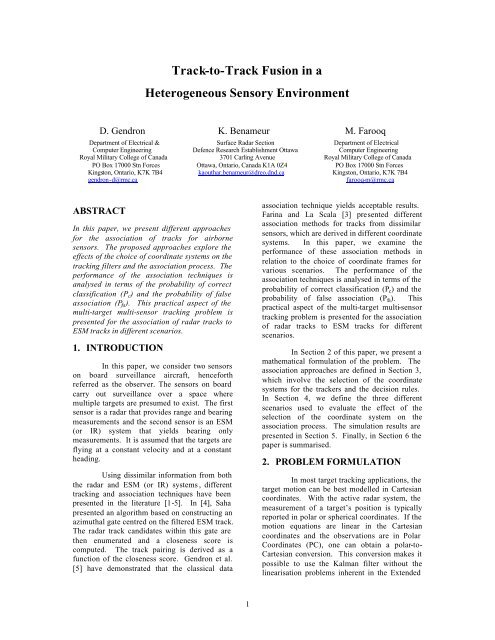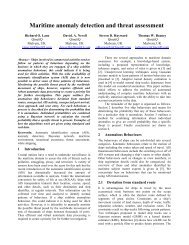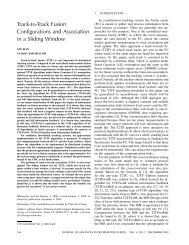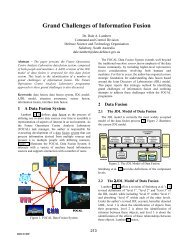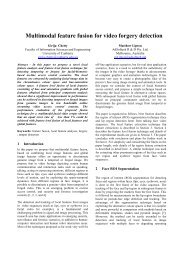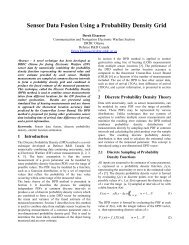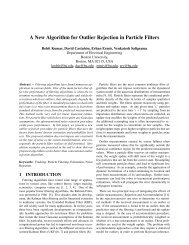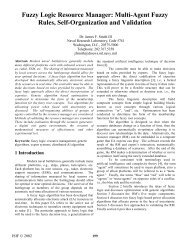Track-to-Track Fusion in a Heterogeneous Sensory Environment - ISIF
Track-to-Track Fusion in a Heterogeneous Sensory Environment - ISIF
Track-to-Track Fusion in a Heterogeneous Sensory Environment - ISIF
Create successful ePaper yourself
Turn your PDF publications into a flip-book with our unique Google optimized e-Paper software.
<strong>Track</strong>-<strong>to</strong>-<strong>Track</strong> <strong>Fusion</strong> <strong>in</strong> a<br />
<strong>Heterogeneous</strong> <strong>Sensory</strong> <strong>Environment</strong><br />
D. Gendron K. Benameur M. Farooq<br />
Department of Electrical & Surface Radar Section Department of Electrical<br />
Computer Eng<strong>in</strong>eer<strong>in</strong>g Defence Research Establishment Ottawa Computer Eng<strong>in</strong>eer<strong>in</strong>g<br />
Royal Military College of Canada 3701 Carl<strong>in</strong>g Avenue Royal Military College of Canada<br />
PO Box 17000 Stn Forces Ottawa, Ontario, Canada K1A 0Z4 PO Box 17000 Stn Forces<br />
K<strong>in</strong>gs<strong>to</strong>n, Ontario, K7K 7B4 kaouthar.benameur@dreo.dnd.ca K<strong>in</strong>gs<strong>to</strong>n, Ontario, K7K 7B4<br />
gendron-d@rmc.ca<br />
farooq-m@rmc.ca<br />
ABSTRACT<br />
In this paper, we present different approaches<br />
for the association of tracks for airborne<br />
sensors. The proposed approaches explore the<br />
effects of the choice of coord<strong>in</strong>ate systems on the<br />
track<strong>in</strong>g filters and the association process. The<br />
performance of the association techniques is<br />
analysed <strong>in</strong> terms of the probability of correct<br />
classification (P c ) and the probability of false<br />
association (P fa ). This practical aspect of the<br />
multi-target multi-sensor track<strong>in</strong>g problem is<br />
presented for the association of radar tracks <strong>to</strong><br />
ESM tracks <strong>in</strong> different scenarios.<br />
1. INTRODUCTION<br />
In this paper, we consider two sensors<br />
on board surveillance aircraft, henceforth<br />
referred as the observer. The sensors on board<br />
carry out surveillance over a space where<br />
multiple targets are presumed <strong>to</strong> exist. The first<br />
sensor is a radar that provides range and bear<strong>in</strong>g<br />
measurements and the second sensor is an ESM<br />
(or IR) system that yields bear<strong>in</strong>g only<br />
measurements. It is assumed that the targets are<br />
fly<strong>in</strong>g at a constant velocity and at a constant<br />
head<strong>in</strong>g.<br />
Us<strong>in</strong>g dissimilar <strong>in</strong>formation from both<br />
the radar and ESM (or IR) systems , different<br />
track<strong>in</strong>g and association techniques have been<br />
presented <strong>in</strong> the literature [1-5]. In [4], Saha<br />
presented an algorithm based on construct<strong>in</strong>g an<br />
azimuthal gate centred on the filtered ESM track.<br />
The radar track candidates with<strong>in</strong> this gate are<br />
then enumerated and a closeness score is<br />
computed. The track pair<strong>in</strong>g is derived as a<br />
function of the closeness score. Gendron et al.<br />
[5] have demonstrated that the classical data<br />
association technique yields acceptable results.<br />
Far<strong>in</strong>a and La Scala [3] presented different<br />
association methods for tracks from dissimilar<br />
sensors, which are derived <strong>in</strong> different coord<strong>in</strong>ate<br />
systems. In this paper, we exam<strong>in</strong>e the<br />
performance of these association methods <strong>in</strong><br />
relation <strong>to</strong> the choice of coord<strong>in</strong>ate frames for<br />
various scenarios. The performance of the<br />
association techniques is analysed <strong>in</strong> terms of the<br />
probability of correct classification (P c ) and the<br />
probability of false association (P fa ). This<br />
practical aspect of the multi-target multi-sensor<br />
track<strong>in</strong>g problem is presented for the association<br />
of radar tracks <strong>to</strong> ESM tracks for different<br />
scenarios.<br />
In Section 2 of this paper, we present a<br />
mathematical formulation of the problem. The<br />
association approaches are def<strong>in</strong>ed <strong>in</strong> Section 3,<br />
which <strong>in</strong>volve the selection of the coord<strong>in</strong>ate<br />
systems for the trackers and the decision rules.<br />
In Section 4, we def<strong>in</strong>e the three different<br />
scenarios used <strong>to</strong> evaluate the effect of the<br />
selection of the coord<strong>in</strong>ate system on the<br />
association process. The simulation results are<br />
presented <strong>in</strong> Section 5. F<strong>in</strong>ally, <strong>in</strong> Section 6 the<br />
paper is summarised.<br />
2. PROBLEM FORMULATION<br />
In most target track<strong>in</strong>g applications, the<br />
target motion can be best modelled <strong>in</strong> Cartesian<br />
coord<strong>in</strong>ates. With the active radar system, the<br />
measurement of a target’s position is typically<br />
reported <strong>in</strong> polar or spherical coord<strong>in</strong>ates. If the<br />
motion equations are l<strong>in</strong>ear <strong>in</strong> the Cartesian<br />
coord<strong>in</strong>ates and the observations are <strong>in</strong> Polar<br />
Coord<strong>in</strong>ates (PC), one can obta<strong>in</strong> a polar-<strong>to</strong>-<br />
Cartesian conversion. This conversion makes it<br />
possible <strong>to</strong> use the Kalman filter without the<br />
l<strong>in</strong>earisation problems <strong>in</strong>herent <strong>in</strong> the Extended<br />
1
Kalman Filter (EKF), however, the nonl<strong>in</strong>earities<br />
are imbedded <strong>in</strong> the noise processes.<br />
The result<strong>in</strong>g filter is called the Converted<br />
Measurement Kalman Filter (CMKF).<br />
2.1 Converted Measurement Kalman<br />
Filter<br />
The active sensor provides noisy<br />
measurements of the target(s) bear<strong>in</strong>g (β), as<br />
well as the target(s) range (r). The state space<br />
model used for the active sensor measurement<br />
filter is represented by the follow<strong>in</strong>g equations:<br />
where<br />
x ( k 1) = Φx(<br />
k ) + w(<br />
k ) + U(<br />
k)<br />
+ , (1)<br />
[ x x&<br />
y y&<br />
] T<br />
x =<br />
(2)<br />
is the relative state vec<strong>to</strong>r and where the<br />
superscript "T" represents the transpose<br />
operation. F def<strong>in</strong>es the state transition matrix,<br />
w(k) is a zero-mean, white, Gaussian noise<br />
sequence with assumed covariance Q, and U(k)<br />
is the assumed determ<strong>in</strong>istic <strong>in</strong>put such as the<br />
relative position change (acceleration) of the<br />
observer. The measurement vec<strong>to</strong>r z is modelled<br />
as<br />
where<br />
z ( k)<br />
Cx(<br />
k ) + v(<br />
k )<br />
= , (3)<br />
⎡x<br />
( k)<br />
= ⎢<br />
⎣y<br />
m<br />
m<br />
( k)<br />
⎤<br />
( k)<br />
⎥<br />
⎦<br />
z , (4)<br />
⎡1<br />
= ⎢<br />
⎣0<br />
0<br />
0<br />
0<br />
1<br />
0⎤<br />
0<br />
⎥<br />
⎦<br />
C , and (5)<br />
⎛cos(<br />
β<br />
( k)<br />
=<br />
⎜<br />
⎝ s<strong>in</strong>( β<br />
)<br />
−r<br />
⎞⎛η<br />
m<br />
s<strong>in</strong>( βm)<br />
⎟⎜<br />
r β<br />
m<br />
cos(<br />
m)<br />
⎠⎝<br />
m<br />
r<br />
v (6)<br />
η<br />
m)<br />
β<br />
where the subscript "m" denotes the measured<br />
quantities, and η r and η β are zero -mean, white,<br />
Gaussian noise processes for the range and the<br />
bear<strong>in</strong>g, respectively. In the CMKF, the polar<br />
measurements, the measured range and bear<strong>in</strong>g<br />
m<br />
2<br />
m<br />
r x + y<br />
m<br />
2<br />
⎞<br />
⎟<br />
⎠<br />
= , and (7)<br />
−1⎛<br />
y ⎞<br />
m<br />
β =<br />
⎜<br />
⎟<br />
m<br />
tan<br />
(8)<br />
⎝ xm<br />
⎠<br />
are converted <strong>in</strong><strong>to</strong> the Cartesian form by the<br />
standard coord<strong>in</strong>ate transformation<br />
x<br />
= cos( β ) m<br />
, and (9)<br />
m<br />
r m<br />
ym r m<br />
s<strong>in</strong>( β ) m<br />
= . (10)<br />
2.2 Extended Kalman Filter with<br />
Modified Polar Coord<strong>in</strong>ates<br />
The EKF is basically an extension of<br />
the L<strong>in</strong>ear Kalman Filter (LKF). The difference<br />
is that the EKF is employed <strong>to</strong> handle the case of<br />
non-l<strong>in</strong>ear measurement process and/or nonl<strong>in</strong>ear<br />
target dynamics. The basic idea is <strong>to</strong><br />
l<strong>in</strong>earise the non-l<strong>in</strong>earities about each estimate<br />
once it has been computed. As soon as a new<br />
state estimate is produced, a new and hopefully<br />
more accurate reference state trajec<strong>to</strong>ry is<br />
<strong>in</strong>corporated <strong>in</strong><strong>to</strong> the estimation process. So, the<br />
update equation becomes<br />
xˆ(<br />
k | k)<br />
= xˆ(<br />
k | k −1)<br />
+<br />
K(<br />
k )[ z(<br />
k)<br />
− h( xˆ(<br />
k | k −1))]<br />
(11)<br />
where h( x ˆ( k | k −1))<br />
is a non-l<strong>in</strong>ear<br />
measurement function. The ga<strong>in</strong> is def<strong>in</strong>ed as<br />
K(<br />
k)<br />
= P(<br />
k | k −1)<br />
H<br />
[ H<br />
x<br />
( k)<br />
P(<br />
k | k −1)<br />
H<br />
T<br />
x<br />
T<br />
x<br />
( k)<br />
( k)<br />
+ R(<br />
k)]<br />
−1<br />
(12)<br />
where H x (k) is the l<strong>in</strong>earised measurement<br />
matrix expressed as<br />
H . (13)<br />
x( k)<br />
= ∇<br />
xh(<br />
x,<br />
k)<br />
x=<br />
xˆ(<br />
k|<br />
k−1)<br />
Aidala and Hammel [6] have proposed<br />
a different set of equations for the state and<br />
measurement formulated <strong>in</strong> terms of Modified<br />
Polar Coord<strong>in</strong>ates (MPC), while the algorithm<br />
itself is configured as an EKF <strong>to</strong> solve the<br />
bear<strong>in</strong>g only Target Motion Analysis (TMA)<br />
problem. The state vec<strong>to</strong>r <strong>in</strong> MPC is<br />
[ β & r&<br />
β 1 ] T<br />
y =<br />
, (14)<br />
r r<br />
2
where β & represents the relative bear<strong>in</strong>g rate,<br />
r& is the ratio of the relative range rate and the<br />
r<br />
relative range, and is the measure of the<br />
closeness of the observer <strong>to</strong> the target, which is<br />
called Inverse-Time-To-Go (ITTG), β is the<br />
relative bear<strong>in</strong>g and (1 / r) represents the <strong>in</strong>verse<br />
of the relative range. This coord<strong>in</strong>ate frame is<br />
well suited for TMA as it au<strong>to</strong>matically<br />
decouples the observable and unobservable<br />
components of the state vec<strong>to</strong>r. It is <strong>to</strong> be noted<br />
that the first three terms of the state vec<strong>to</strong>r are<br />
always observable while, the last term, (1 / r), is<br />
not observable until the observer performs a<br />
manoeuvre. The analysis <strong>in</strong> [7] reveals that the<br />
observer must manoeuvre <strong>to</strong> render the system<br />
observable and that certa<strong>in</strong> manoeuvres are more<br />
appropriate than others for a given observer<br />
speed and profile. The target course is def<strong>in</strong>ed by<br />
the follow<strong>in</strong>g non-l<strong>in</strong>ear differential equations:<br />
⎡−<br />
2y1<br />
y2<br />
+ y4(<br />
a<br />
⎢<br />
2 2<br />
dy<br />
⎢y1<br />
− y2<br />
+ y4<br />
( a<br />
=<br />
dt ⎢<br />
⎢<br />
y1<br />
⎢⎣<br />
− y1y4<br />
x<br />
x<br />
cos( y3)<br />
− a<br />
y<br />
s<strong>in</strong>( y3))<br />
⎤<br />
⎥<br />
s<strong>in</strong>( y3)<br />
− a<br />
y<br />
cos( y3))<br />
⎥<br />
⎥<br />
⎥<br />
⎥⎦<br />
(15)<br />
where a x and a y are the Cartesian components of<br />
the observer’s acceleration.<br />
2.3 Polar Coord<strong>in</strong>ates<br />
The algorithm that follows is<br />
represented <strong>in</strong> Polar Coord<strong>in</strong>ate (PC). In this<br />
coord<strong>in</strong>ate frame, the filter simply smoothes the<br />
noisy bear<strong>in</strong>g measurements. The state vec<strong>to</strong>r<br />
for the PC is as follows:<br />
p<br />
[ β & r&<br />
β r] T<br />
x =<br />
. (16)<br />
The non-l<strong>in</strong>ear differential equations describ<strong>in</strong>g<br />
the evolution of the target course <strong>in</strong> this<br />
coord<strong>in</strong>ate system are described <strong>in</strong> equation (17):<br />
dx<br />
p<br />
=<br />
dt<br />
⎡ 2xp2<br />
⎢<br />
−<br />
⎢<br />
2<br />
⎢xp1xp<br />
4<br />
⎢<br />
⎢xp1<br />
⎢<br />
⎣xp<br />
2<br />
(17)<br />
x<br />
p1<br />
x<br />
p4<br />
( a<br />
+<br />
+ ( a s<strong>in</strong>( x<br />
x<br />
x<br />
p3<br />
cos( x<br />
) − a<br />
y<br />
p3<br />
) − a<br />
cos( x<br />
y<br />
p3<br />
2.4 Classical Data Association<br />
Technique<br />
s<strong>in</strong>( x<br />
))<br />
p3<br />
))<br />
x<br />
Assum<strong>in</strong>g the two target tracks<br />
are xˆ<br />
radar<br />
and xˆ<br />
esm<br />
for the active and passive<br />
cases, respectively, the association logic test,<br />
referred <strong>to</strong> as the statistical distance test statistic,<br />
is<br />
ij −1<br />
T<br />
(ˆ x − xˆ<br />
)( P ) (ˆ x − xˆ<br />
≤ λ ,<br />
radar esm<br />
radar esm<br />
)<br />
where<br />
P<br />
(18)<br />
ij i j c c T<br />
= Pa<br />
+ Pp<br />
−P<br />
−(P<br />
) , (19)<br />
and P i j<br />
a and P p are the solutions of the Ricatti<br />
equations for the Kalman filters [3] used for the<br />
active and passive cases, respectively, assum<strong>in</strong>g<br />
the process noise is Gaussian and <strong>in</strong>dependent<br />
for each filter. In general, the cross-covariance<br />
term P c will not be zero as the state estimate<br />
errors will be correlated if the trajec<strong>to</strong>ries are<br />
from the same target due <strong>to</strong> the common process<br />
noise <strong>in</strong> each filter. In the current study, the<br />
cross-covariance is assumed <strong>to</strong> be zero. The<br />
expression <strong>in</strong> equation (18) represents a χ 2<br />
distribution with n degrees of freedom and λ is<br />
selected from the χ 2 tables.<br />
3. ASSOCIATION RULES<br />
Five track-<strong>to</strong>-track association<br />
approaches proposed <strong>in</strong> [3] are considered here.<br />
The first two techniques are commonly used<br />
methods while the three re ma<strong>in</strong><strong>in</strong>g were<br />
<strong>in</strong>troduced <strong>in</strong> [3]. Two of the newer association<br />
techniques make use of the ITTG (G = r?/ r)<br />
element available from the MPC filter. The five<br />
association methodologies, as presented <strong>in</strong><br />
Figure 1, are:<br />
p4<br />
⎤<br />
⎥<br />
⎥<br />
⎥<br />
⎥<br />
⎥<br />
⎥<br />
⎦<br />
3
a) Method 1 compares the bear<strong>in</strong>g<br />
estimates from the active filter<br />
βˆ with the bear<strong>in</strong>g estimates<br />
radar<br />
from the PC filter<br />
ˆβ ;<br />
1esm<br />
b) Method 2 compares βˆ radar<br />
with<br />
the bear<strong>in</strong>g estimates from the<br />
MPC filter<br />
ˆβ 2 ;<br />
esm<br />
c) Method 3 compares the bear<strong>in</strong>g and<br />
the ITTG estimates from the active<br />
ˆβ with the<br />
filter [<br />
radar,<br />
Ĝ radar<br />
]<br />
bear<strong>in</strong>g and ITTG estimates from<br />
the MPC filter [ 2esm,<br />
G2 ˆ<br />
esm<br />
]<br />
ˆβ ;<br />
d) Method 4 compares βˆ<br />
radar<br />
, with<br />
the measured bear<strong>in</strong>g<br />
ESM system; and<br />
β<br />
m<br />
from the<br />
e) Method 5 compares<br />
[ ˆβ<br />
radar,<br />
Ĝ radar<br />
] with β<br />
m<br />
and<br />
ˆ .<br />
G2 esm<br />
4. SIMULATION SCENARIOS<br />
4.1 Profile A<br />
In what follows, we describe three<br />
different scenarios analysed <strong>in</strong> this study. Under<br />
the assumption that the ESM and radar<br />
measurements are synchronised, Profile A<br />
represents a scenario where the targets are<br />
mov<strong>in</strong>g <strong>to</strong>ward the observer at a constant speed<br />
and head<strong>in</strong>g as shown <strong>in</strong> Figure 2. We also<br />
assume that the observer’s trajec<strong>to</strong>ry is known.<br />
The <strong>in</strong>itial position and velocity <strong>in</strong><br />
Cartesian coord<strong>in</strong>ates of the observer and the two<br />
targets for Profile A, are respectively: (0 km, 50<br />
km, 200 m/s, 0 m/s), (150 km, 3 km, -150 m/s, 0<br />
m/s), and (150 km, 7 km, -150 m/s, 0 m/s). The<br />
distance between the two targets is 4 km for each<br />
profile.<br />
4.2 Profile B<br />
Profile B shows a scenario where the<br />
targets are mov<strong>in</strong>g away from the observer at a<br />
constant velocity and bear<strong>in</strong>g as shown <strong>in</strong> Figure<br />
3.<br />
The <strong>in</strong>itial position and velocity <strong>in</strong><br />
Cartesian coord<strong>in</strong>ates of the observer and the two<br />
targets for Profile A, are respectively: (0 km, 0<br />
km, 200 m/s, 0 m/s), (50 km, 50 km, 150 m/s, 0<br />
m/s), and (50 km, 54 km, 150 m/s, 0 m/s).<br />
4.3 Profile C<br />
The f<strong>in</strong>al scenario is Profile C. In this<br />
profile, the targets are still mov<strong>in</strong>g away from<br />
the observer at a constant speed and head<strong>in</strong>g, but<br />
the targets are fly<strong>in</strong>g at a 45 degree angle as<br />
shown <strong>in</strong> Figure 4.<br />
This geometry offers a good<br />
compromise between <strong>in</strong>creased bear<strong>in</strong>g rate and<br />
reduced relative range allow<strong>in</strong>g the velocity<br />
errors <strong>to</strong> be m<strong>in</strong>imised. This, <strong>in</strong> turn, will benefit<br />
the ESM filters as the bear<strong>in</strong>g rate is <strong>in</strong>creased<br />
when the observer crosses the target’s L<strong>in</strong>e Of<br />
Sight (LOS), which results <strong>in</strong> a substantially<br />
improved estimation of the bear<strong>in</strong>g [7]. The<br />
<strong>in</strong>itial position and velocity <strong>in</strong> Cartesian<br />
coord<strong>in</strong>ates of the observer and the two targets<br />
for Profile A, are respectively: (0 km, 0 km, 200<br />
m/s, 0 m/s), (60 km, 40 km, 150cos(45°) m/s,<br />
150s<strong>in</strong>(45°) m/s), and (60 km, 44 km,<br />
150cos(45°) m/s, 150s<strong>in</strong>(45°) m/s).<br />
5. SIMULATION RESULTS<br />
A number of Monte Carlo simulations<br />
have been carried out for the three def<strong>in</strong>ed<br />
profiles <strong>to</strong> determ<strong>in</strong>e the performance of the five<br />
different association techniques. The sampl<strong>in</strong>g<br />
period (T) is chosen <strong>to</strong> be 4 seconds. One<br />
hundred runs were performed for every case<br />
under consideration. The measurement noises<br />
were set as follows:<br />
a) Range noise σ<br />
r<br />
= 10 m;<br />
b) Bear<strong>in</strong>g noise σ<br />
βa<br />
for the active<br />
sensor = 1 degree; and<br />
c) Bear<strong>in</strong>g noise σ<br />
βp<br />
for the passive<br />
sensor = 3 degrees.<br />
The performance of these techniques is<br />
compared <strong>in</strong> terms of Probability of False<br />
Association (P fa ) and Probability of Correct (P c )<br />
association.<br />
Simulation results reveal that P c<br />
presents a similar performance for Profiles B and<br />
C. However, we observe a strong deterioration<br />
4
<strong>in</strong> the P c performance for Profile A <strong>in</strong> the case of<br />
Method 1. This poor performance is attributed <strong>to</strong><br />
the PC model, which is a not a good choice for<br />
extrapolat<strong>in</strong>g target position between sensor<br />
updates. This is particularly true at shorter<br />
ranges, where the pseudo-accelerations created<br />
by constant speed/constant course targets,<br />
<strong>in</strong>troduce very large errors <strong>in</strong> polar track<strong>in</strong>g [8],<br />
which is the case of Profile A (Figure 5), where<br />
the targets are mov<strong>in</strong>g <strong>to</strong>ward the observer<br />
caus<strong>in</strong>g the range <strong>to</strong> decrease rapidly.<br />
Consider<strong>in</strong>g P fa , simulation results show<br />
that the performance depends strongly on the<br />
profile and the association rules. Figures 6, 7,<br />
and 8 clearly demonstrate that the P fa<br />
performance is a function of the tracker<br />
coord<strong>in</strong>ate system as well as the profile<br />
geometry. Note that the P c is 95 % <strong>in</strong> these<br />
simulations.<br />
To further evaluate the performance of<br />
the five track-<strong>to</strong>-track association methods <strong>in</strong><br />
terms of P fa , the curves illustrat<strong>in</strong>g the<br />
percentage of false association versus the<br />
distance separat<strong>in</strong>g the two targets is shown <strong>in</strong><br />
Figures 9, 10, and 11 for each profile. These<br />
plots allow us <strong>to</strong> determ<strong>in</strong>e if the approaches can<br />
dist<strong>in</strong>guish between two closely spaced targets.<br />
The results presented <strong>in</strong> Figures 9 <strong>to</strong> 11<br />
demonstrate that Methods 1, 2, and 3, which use<br />
bear<strong>in</strong>g estimates, are better than Methods 4 and<br />
5, which use noisy bear<strong>in</strong>g measurements <strong>in</strong><br />
dist<strong>in</strong>guish<strong>in</strong>g between two targets. Moreover,<br />
the performance of each method improves as the<br />
distance between the targets <strong>in</strong>creases as<br />
expected. Unlike the results presented <strong>in</strong> [3], the<br />
results of this study do not demonstrate that the<br />
methods (Methods 2 and 3) us<strong>in</strong>g the MPC filter<br />
are better than Method 1. The dissimilar results<br />
are attributed <strong>to</strong> the type of profiles utilised <strong>in</strong><br />
this study.<br />
while Methods 4 and 5, which rely on measured<br />
ESM bear<strong>in</strong>g for the association between tracks,<br />
are not reliable. The study also demonstrates<br />
that association Method 1, us<strong>in</strong>g the PC based<br />
estimates, and Method 2, us<strong>in</strong>g the MPC based<br />
estimates, have comparable performances.<br />
REFERENCES<br />
[1] A. Far<strong>in</strong>a and R. Miglioli, "Association of<br />
active and passive tracks for airborne sensors",<br />
Signal Process<strong>in</strong>g 69, pp. 209-217, 1998.<br />
[2] F. R. Castella, "Theoretical performance of a<br />
multisensor track-<strong>to</strong>-track correlation technique",<br />
IEE Proceed<strong>in</strong>g, Radar, Sonar and Navigation,<br />
Vol. 142, No. 6, December 1995.<br />
[3] A. Far<strong>in</strong>a and B. La Scala, "Methods for the<br />
Association of Active and Passive <strong>Track</strong>s for<br />
Airborne Sensors".<br />
[4] R. K. Saha, “Analytical evaluation of an<br />
ESM/radar track association algorithm”, SPIE,<br />
Vol. 1698, Signal and Data Process<strong>in</strong>g of Small<br />
Targets, 1992.<br />
[5] D. Gendron, M. Farooq, K. Benameur,<br />
“<strong>Track</strong>-<strong>to</strong>-<strong>Track</strong> <strong>Fusion</strong> <strong>in</strong> a Multisensory<br />
<strong>Environment</strong>”, SPIE Proceed<strong>in</strong>gs, Vol. 4380,<br />
Signal Process<strong>in</strong>g, Sensor <strong>Fusion</strong>, and Target<br />
Recognition , Orlando April 2001.<br />
[6] V. J. Aidala and S. E. Hammel, “Utilization<br />
of Modified Polar Coord<strong>in</strong>ates for Bear<strong>in</strong>g-Only<br />
<strong>Track</strong><strong>in</strong>g”, IEEE Transactions on Au<strong>to</strong>matic<br />
Control, Vol. AC-28, No. 3, March 1983.<br />
[7] D. Van Huyssteen and M. Farooq,<br />
“Performance analysis of bear<strong>in</strong>gs-only track<strong>in</strong>g<br />
algorithm”, 1998 Aerosense Conference of SPIE,<br />
Orlando, FL, April 1998.<br />
[8] Y. Bar-Shalom, W. D. Blair, “Multitarget-<br />
Multisensor <strong>Track</strong><strong>in</strong>g: Applications and<br />
Advances”, Volume III, Artech House, 2000.<br />
6. CONCLUSION<br />
In this paper, we explored the problem<br />
of associat<strong>in</strong>g ESM tracks with one or more<br />
possible radar tracks derived <strong>in</strong> different<br />
coord<strong>in</strong>ate systems. Simulations results show<br />
that the choice of the coord<strong>in</strong>ate system is a<br />
complex issue, which depends not only on the<br />
sensors but also on the scenario. One important<br />
outcome of this study is that Methods 1,2 and 3,<br />
which use bear<strong>in</strong>g estimates <strong>to</strong> compute the<br />
track-<strong>to</strong>-track association, are capable of<br />
correctly associat<strong>in</strong>g two closely spaced targets,<br />
5
Figure 1, Association Rules [3]<br />
6 x 104 Profile A, True <strong>Track</strong>s<br />
5<br />
Observer<br />
Target A<br />
Target B<br />
4<br />
3<br />
2<br />
Y position <strong>in</strong> Meters<br />
1<br />
0<br />
0 2 4 6 8 10 12 14 16<br />
X position <strong>in</strong> Meters<br />
x 10 4<br />
Figure 2, True <strong>Track</strong>s for Profile A<br />
Profile B, True <strong>Track</strong>s<br />
6 x 104 X position <strong>in</strong> Meters<br />
5<br />
4<br />
3<br />
2<br />
Y position <strong>in</strong> Meters<br />
1<br />
Observer<br />
Target A<br />
Target B<br />
0<br />
0 2 4 6 8 10 12 14 16<br />
x 10 4<br />
Figure 3, True <strong>Track</strong>s for Profile B<br />
6
x 10 4<br />
Profile C, True <strong>Track</strong>s<br />
12<br />
10<br />
Observer<br />
Target A<br />
Target B<br />
8<br />
6<br />
Y position 4 <strong>in</strong> Meters<br />
2<br />
0<br />
0 5 10 15<br />
X position <strong>in</strong> Meters<br />
x 10 4<br />
Figure 4, True <strong>Track</strong>s for Profile C<br />
Figure 7, P fa for Profile B<br />
7 x 104 Profile A, True <strong>Track</strong>s & ESM (Polar) <strong>Track</strong> Estimates<br />
6<br />
5<br />
Observer<br />
Target A<br />
TA Estimates<br />
Target B<br />
TB Estimates<br />
4<br />
3<br />
Y position<br />
2<br />
<strong>in</strong> Meters<br />
1<br />
0<br />
0 5 10 15<br />
X position <strong>in</strong> Meters<br />
x 10 4<br />
Figure 5, PC Filter with Profile A<br />
Figure 8, P fa for Profile C<br />
Figure 6, P fa for Profile A<br />
Figure 9, P fa vs Distance Between Targets for Profile A<br />
7
Figure 10, P fa vs Distance Between Targets for Profile B<br />
Figure 11, P fa vs Distance Between Targets for Profile C<br />
8


